Using SpiraTeam with Redmine¶
This section outlines how to use SpiraTeam in conjunction with the open-source Redmine bug-tracking and project management system. The built-in integration service allows the quality assurance team to manage their requirements and test cases in SpiraTeam, execute test runs in SpiraTeam, and then have the new incidents generated during the run be automatically loaded into Redmine. Once the incidents are loaded into Redmine as issues, the development team can then manage the lifecycle of these issues in Redmine, and have the status changes in Redmine be reflected back in SpiraTeam.
In addition, any issues logged directly into Redmine will get imported into SpiraTeam so that they can be linked to test cases and requirements.
Set up data synchronization
STOP! Please make sure you have first read the instructions to set up the data sync before proceeding!
Configuring the Plug-In¶
The next step is to configure the plug-in within SpiraTeam so that the system knows how to access the Redmine server. To start the configuration, please open up SpiraTeam in a web browser, log in using a valid account that has System-Administration level privileges and click on the System > Data Synchronization administration option from the left-hand navigation:

This screen lists all the plug-ins already configured in the system. Depending on whether you chose the option to include sample data in your installation or not, you will see either an empty screen or a list of sample data-synchronization plug-ins.
If you already see an entry for RedmineDataSync you should click on its "Edit" link. If you don't see such an entry in the list, please click on the [Add] button instead. In either case you will be taken to the following screen where you can enter or modify the Redmine Data-Synchronization plug-in:
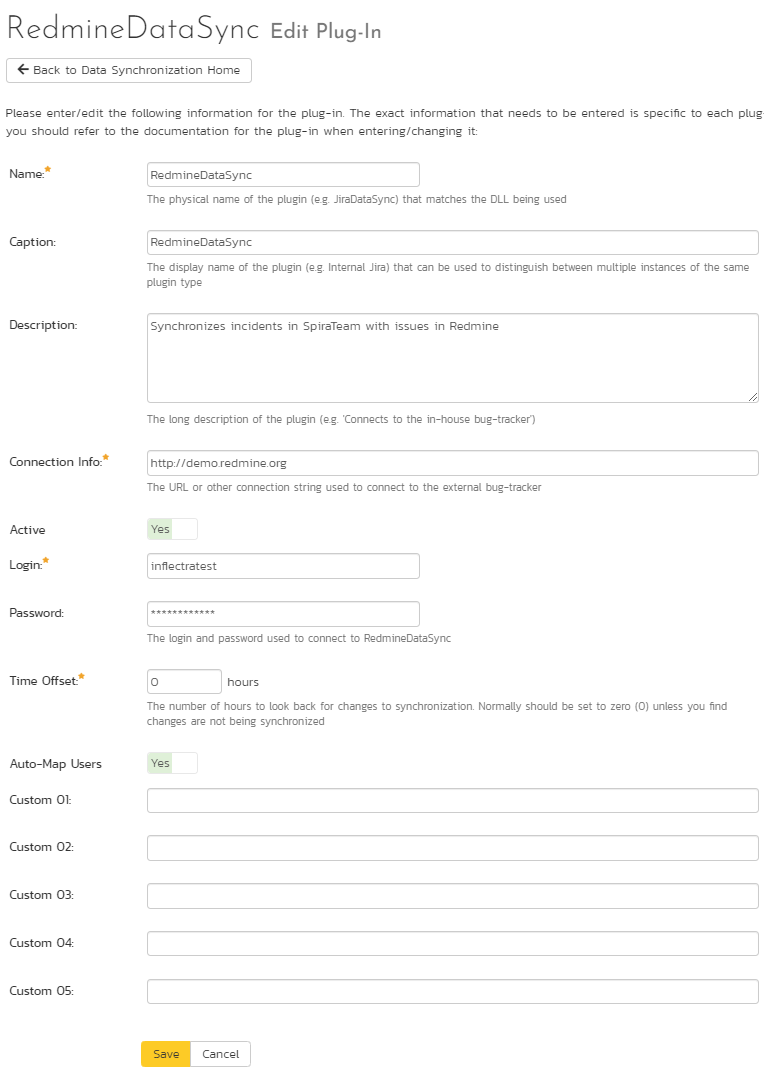
You need to fill out the following fields for the Redmine Plug-in to operate correctly:
-
Name -- this needs to be set to RedmineDataSync. This needs to match the name of the plug-in DLL assembly that was copied into the C:\Program Files\SpiraTeam\Bin folder (minus the .dll file extension). If you renamed the RedmineDataSync.dll file for any reason, then you need to change the name here to match.
-
Description -- this should be set to a description of the plug-in. This is an optional field that is used for documentation purposes and is not actually used by the system.
-
Connection Info -- this should be the base URL of the Redmine installation. As an example, for the public demo installation of Redmine, it would be: http://demo.redmine.org
-
Login -- this should be set to a valid login to the Redmine installation -- the login needs to have permissions to create and view bugs and versions within Redmine.
-
Password -- this should be set to the password of the login specified above.
-
Time Offset -- normally this should be set to zero, but if you find that issues being changed in Redmine are not being updated in SpiraTeam, try increasing the value as this will tell the data-synchronization plug-in to add on the time offset (in hours) when comparing date-time stamps. Also if your Redmine installation is running on a server set to a different time-zone, then you should add in the number of hours difference between the servers' time-zones here.
-
Auto-Map Users -- This changes the way that the plugin maps users in SpiraTeam to those in Redmine:
-
**Auto-Map = True **With this setting, all users in SpiraTeam need to have the same username as those in Redmine. If this is the case then you do not need to perform the user-mapping task. This is a big time-saver if you can guarantee that all usernames are the same in both systems.
-
**Auto-Map = False **With this setting, users in SpiraTeam and Redmine are free to have different usernames because you specify the corresponding Redmine name for each user as outlined in Configuring the User Mapping.
-
Custom 01 -- This should be set to the word "false" if you want to have the plugin restrict synchronization to not create any new incidents in Spira.
-
Custom 02 -- This should be set to the word "false" if you want to have the plugin restrict synchronization to not create any new issues in Redmine.
-
Custom 03 -- 05 -- these are not currently used by the Redmine data-sync plug-in and can be left blank.
Configuring the Data Mapping¶
Next, you need to configure the data mapping between SpiraTeam and Redmine. This allows the various projects, users, releases, incident types, statuses, priorities and custom property values used in the two applications to be related to each other. This is important, as without a correct mapping, there is no way for the integration service to know that an "Duplicate" incident in SpiraTeam is the same as a "Rejected" bug in Redmine (for example).
The following mapping information needs to be setup in SpiraTeam:
The mapping of the project identifiers for the projects that need to be synchronized
The mapping of users in the system
The mapping of releases (equivalent to Redmine versions) in the system
The mapping of the various standard fields in the system
The mapping of the various custom properties in the system
Each of these is explained in turn below:
Configuring the Project Mapping¶
From the data synchronization administration page, you need to click on the "View Project Mappings" hyperlink next to the Redmine plug-in name. This will take you to the data-mapping home page for the currently selected project:
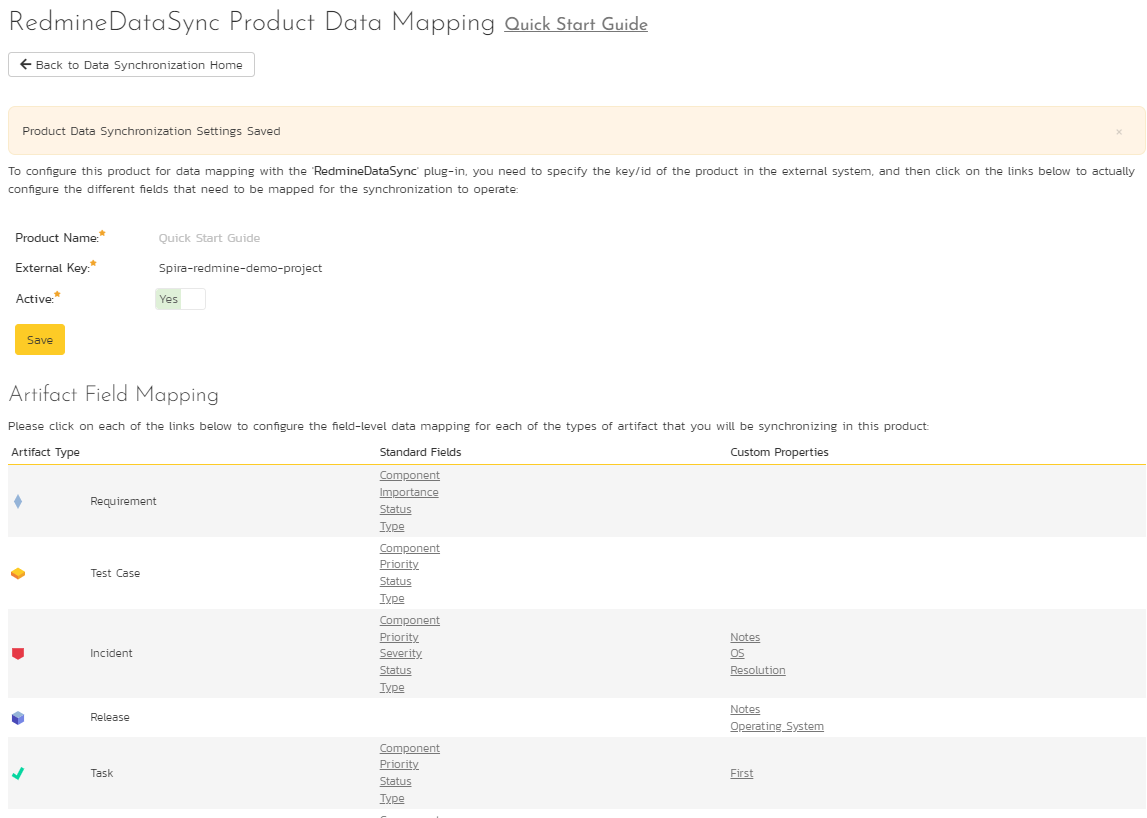
If the project name does not match the name of the project you want to configure the data-mapping for, click on the "(Change Project)" hyperlink to change the current project.
To enable this project for data-synchronization with Redmine, you need to enter:
External Key -- This should be set to the name of the equivalent project in Redmine.
Active Flag -- Set this to 'Yes' so that SpiraTeam knows that you want to synchronize data for this project. Once the project has been completed, setting the value to "No" will stop data synchronization, reducing network utilization.
Click [Update] to confirm these settings. Once you have enabled the project for data-synchronization, you can now enter the other data mapping values outlined below.
Note: Once you have successfully configured the project, when creating a new project, you should choose the option to "Create Project from Existing Project" rather than "Use Default Template" so that all the project mappings get copied across to the new project.
Configuring the User Mapping¶
To configure the mapping of users in the two systems, you need to go to Administration > Users > View Edit Users, which will bring up the list of users in the system. Then click on the "Edit" button for a particular user that will be editing issues in Redmine:
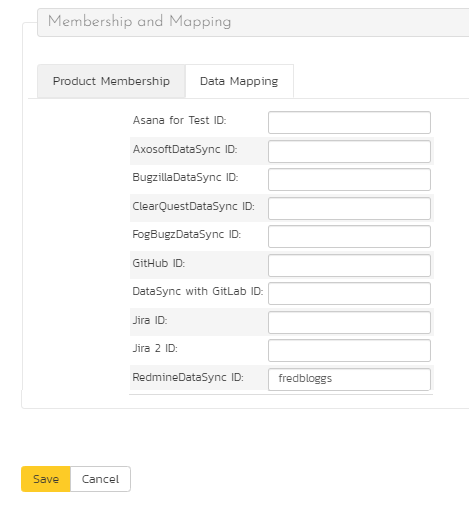
You will notice that in the special Data Mapping tab for the user is a list of all the configured data-synchronization plug-ins. In the text box next to the Redmine Data-Sync plug-in you need to enter the numeric ID for this user in Redmine. This will allow the data-synchronization plug-in to know which user in Redmine matches this SpiraTeam user. Click [Update] once you've entered the appropriate ID value. You should now repeat for the other users who will be active in both systems.
Configuring the Release Mapping¶
Now that the projects and users have been mapped correctly, we need to configure the mapping between Releases/Iterations in SpiraTeam and Versions in Redmine. To do this, please navigate to Planning > Releases and click on the Release/Iteration in question. Make sure you have the 'Overview' tab visible and expand the "Details" section of the release/iteration:
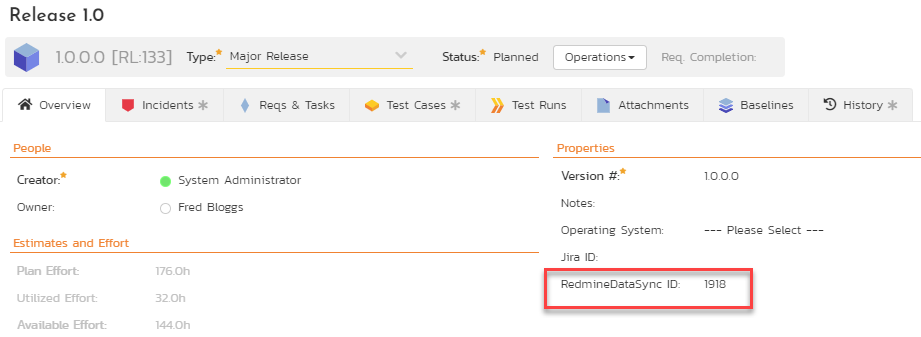
In addition to the standard fields and custom properties configured for Releases, you will see an additional text property called "RedmineDataSync ID" that is used to store the mapped external identifier for the equivalent Version in Redmine. You need to enter the numeric ID of the equivalent version in Redmine, enter it into this text-box and click [Save]. You should now repeat for all the other releases and iterations in the project.
In addition, any Versions that have already been created in Redmine will be automatically imported into SpiraTeam if they do not already exist in SpiraTeam and they have not already been mapped.
Configuring the Standard Field Mapping¶
Now that the projects, user and releases have been mapped correctly, we need to configure the standard incident fields. To do this, go to Administration > System > Data Synchronization and click on the "View Project Mappings" for the RedmineDataSync plug-in entry:

From this screen, you need to click on Priority, Type and Status in turn to configure their values:
a) Incident Status
Click on the "Status" hyperlink under Incident Standard Fields to bring up the Incident status mapping configuration screen:
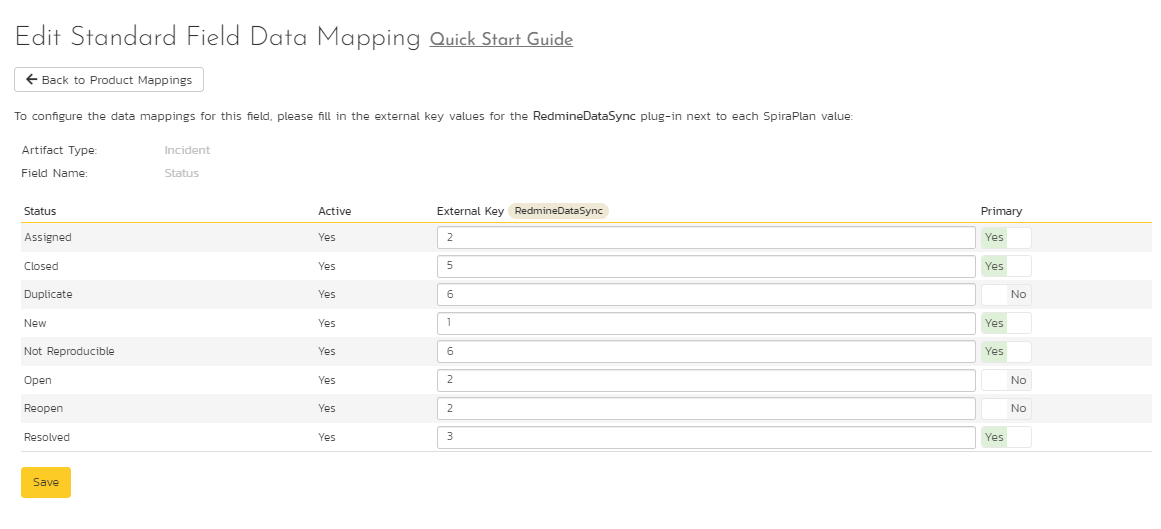
The table lists each of the incident statuses available in SpiraTeam and provides you with the ability to enter the matching Redmine bug status ID for each one. You can map multiple SpiraTeam fields to the same Redmine fields (e.g. Open and Assigned in SpiraTeam are both equivalent to "In Progress" (ID=2) in Redmine), in which case only one of the two values can be listed as Primary = Yes as that's the value that's used on the reverse synchronization (from Redmine > SpiraTeam).
b) Incident Priority
Click on the "Priority" hyperlink under Incident Standard Fields to bring up the Incident Priority mapping configuration screen:
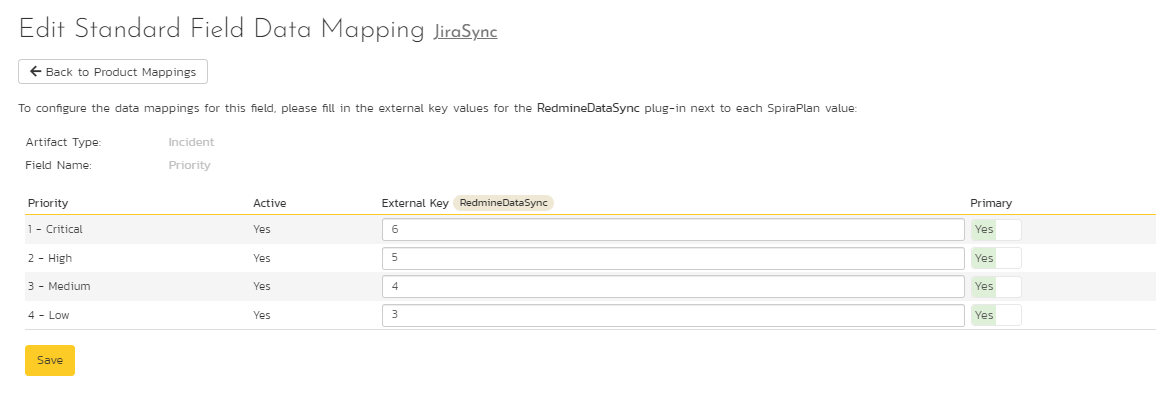
The table lists each of the incident priorities available in SpiraTeam and provides you with the ability to enter the matching Redmine priority ID for each one. You can map multiple SpiraTeam fields to the same Redmine fields, in which case only one of the two values can be listed as Primary = Yes as that's the value that's used on the reverse synchronization (from Redmine > SpiraTeam).
c) Incident Type
Incident types in SpiraTeam are equivalent to Trackers in Redmine. Click on the "Type" hyperlink under Incident Standard Fields to bring up the Incident type mapping configuration screen:
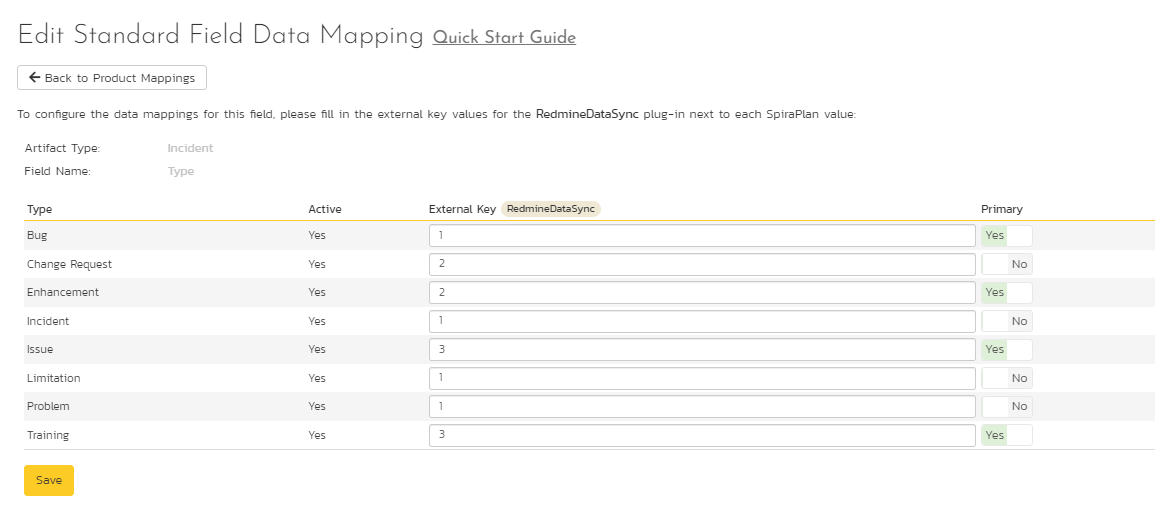
The table lists each of the incident types available in SpiraTeam and provides you with the ability to enter the matching Redmine Tracker ID for each one. You can map multiple SpiraTeam fields to the same Redmine tracker values, in which case only one of the two values can be listed as Primary = Yes as that's the value that's used on the reverse synchronization (from Redmine > SpiraTeam).
Configuring the Custom Property Mapping¶
Now that the various SpiraTeam standard fields have been mapped correctly, we need to configure the custom property mappings. This is used for custom properties in SpiraTeam that map to custom fields in Redmine. You will need to first make sure that the custom properties and associated custom lists have been created in both systems:
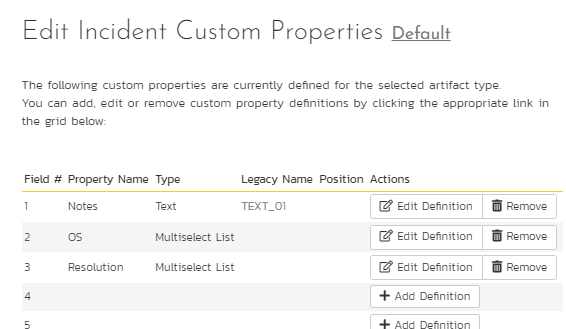
From the View/Edit Project Data Mapping screen, you need to click on the name of the Incident Custom Property that you want to add data-mapping information for:
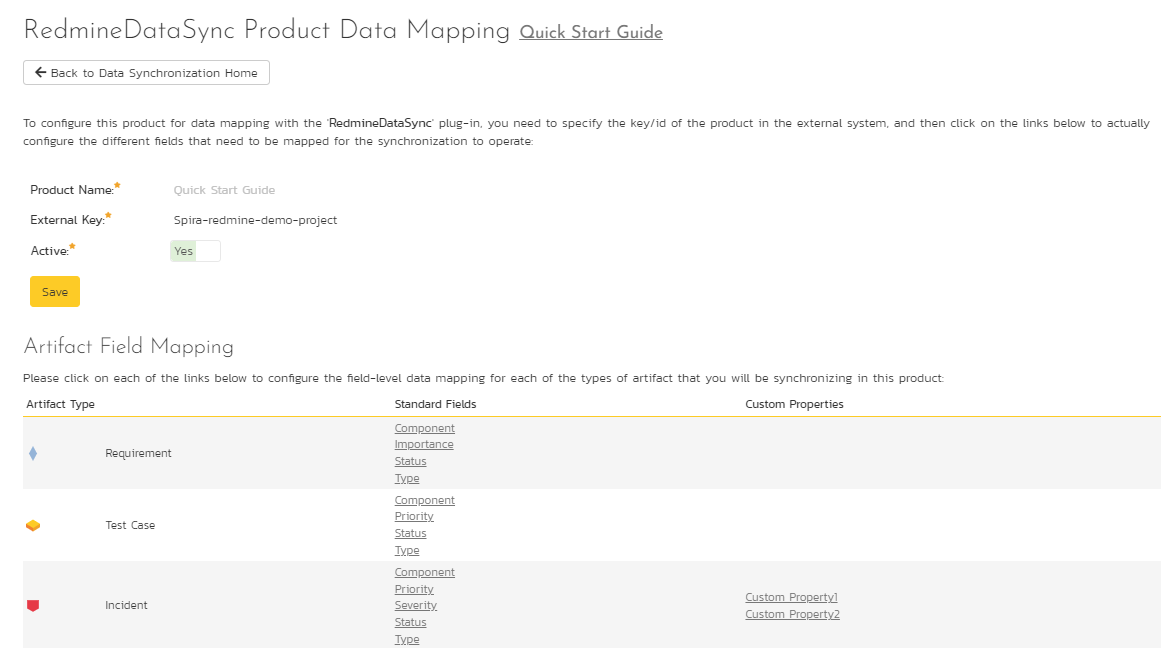
We will consider the two different types of mapping that you might want to enter.
a) Scalar Custom Properties
This refers to custom properties that have a simple user-entered value and don't need to have their specific options mapped between SpiraTeam and Redmine. All of the custom property types except List and Multi-List fall into this category (e.g. Text, Date, Boolean, Decimal, Integer, etc.)
Click on the hyperlink of the scalar custom property under Incident Custom Properties to bring up the custom property mapping configuration screen. For scalar custom properties there will be no values listed in the lower half of the screen.

You need to enter the ID of the custom field in Redmine that matches this custom property in SpiraTeam. Once you have entered the id of the custom field, click [Update].
b) List Custom Properties
This refers to custom properties that are either of type List or Multi-List. Click on the hyperlink of the list custom property under Incident Custom Properties to bring up the custom property mapping configuration screen. For list custom properties there will be a textbox for both the custom field itself and a mapping table for each of the custom property values that need to be mapped:
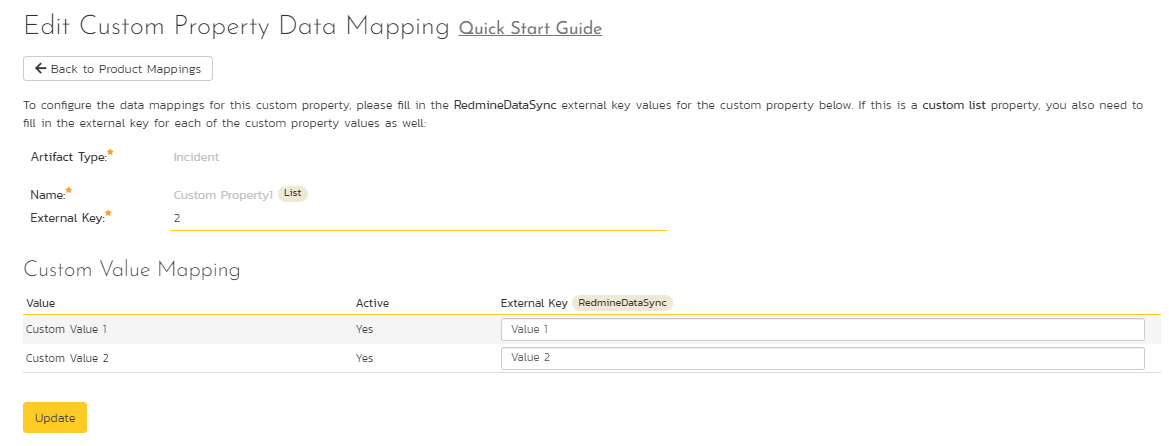
First you need to find the ID of the custom field in Redmine that matches this custom property in SpiraTeam. This should be entered in the 'External Key' field below the name of the custom property.
Next for each of the Property Values in the table (in the lower half of the page) you need to enter the full name (not the id this time) of the custom field value as specified in Redmine.
Once you have updated the various mapping sections, you are now ready to use the service.
Using SpiraTest with Redmine¶
Now that the integration service has been configured and the service started, initially any incidents created in SpiraTeam for the specified projects will be imported into Redmine. At this point we recommend opening the Windows Event Viewer and choosing the Application Log. In this log any error messages raised by the Data Synchronization service will be displayed. If you see any error messages at this point, we recommend immediately stopping the service and checking the various mapping entries. If you cannot see any issues with the mapping information, we recommend sending a copy of the event log message(s) to Inflectra customer services (support@inflectra.com) who will help you troubleshoot the problem.
To use SpiraTeam with Redmine on an ongoing basis, we recommend the following general processes be followed:
When running tests in SpiraTeam, defects found should be logged through the Test Execution Wizard as normal.
Developers can log new defects into either SpiraTeam or Redmine. In either case they will get loaded into the other system.
Once created in one of the systems and successfully replicated to the other system, the incident should not be modified again inside SpiraTeam
All data changes to the issue should be made inside Redmine.
To enforce this, you can modify the workflows set up in SpiraTeam so that the various fields are marked as inactive for all the incident statuses other than the "New" status.
This will allow someone to submit an incident in SpiraTeam, but will prevent them making changes in conflict with Redmine after that point.
As the issue progresses through the Redmine workflow, changes to the status, priority, tracker, and target version will be updated automatically in SpiraTeam, and any notes added will be added to SpiraTeam as new comments. In essence, SpiraTeam acts as a read-only viewer of these incidents.
You are now able to perform test coverage and incident reporting inside SpiraTeam using the test cases managed by SpiraTeam and the incidents managed on behalf of SpiraTeam inside Redmine.